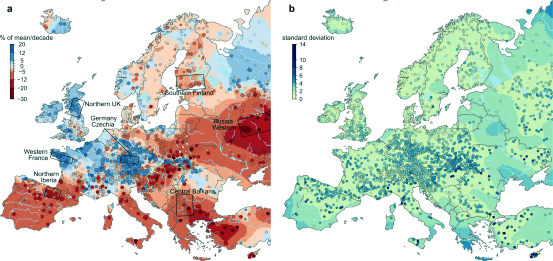FLOODS - Flood drivers and flood change in Europe
Dates: 2018-2020
Funding: various sources
Principal Investigator: Peter Molnar
Floods are a global natural hazard leading to large economic losses, deaths, long-lasting impacts and difficult recovery in many affected poor regions. In a changing climate with shifting rainfall patterns, stronger storms, and rising air temperatures, floods are also likely to change, increase in some areas and decrease in others. In this research we investigated two aspects of floods in Europe: their climatic drivers and the changes in flood properties that can be gleaned from flood peak observations.
Hydrological drivers of floods

Flood changes are complex because they are potentially triggered by a variety of hydrological processes and driving factors such as heavy rainfall, high soil moisture, or snowmelt. Together with colleagues at D-USYS we have analysed the coincidence in the timing of these potential drivers and floods to objectively identify which flood-generating driver is dominant in a particular catchment. This led to the surprising finding that relatively few annual floods were caused by extreme rainfall only, and in fact most European floods in the last 50 years were caused by snowmelt and especially by the concurrence of rainfall and high antecedent soil moisture. This means that changes in flood timing are going to be very closely related to changes in the driving factors of floods and will differ across Europe, shifting flood seasons accordingly.
Berghuijs, W. R., Harrigan, S., Molnar, P., Slater, L. J., & Kirchner, J. W. (2019). external page The relative importance of different flood‐generating mechanisms across Europe, Water Resources Research, 55, 4582–4593
Changes in European flood timing and magnitude

Flood changes in Europe have been the subject of investigation of an international team of researchers led by external page Prof. Günter Blöschl at TU Vienna, including Peter Molnar of ETH Zurich. They showed that changes in flood timing and magnitudes across Europe are indeed spatially heterogeneous and they called for climate change considerations in flood risk management. This work is based on a unique collection of flood data from over 3700 catchments in 38 countries in Europe. Research shows that flood peak discharges in Europe have changed significantly, at rates that range from increases of about 11% to decreases of about 23% per decade relative to the long-term averages. In central and north-western Europe flood peaks have increased because precipitation is increasing and soils are becoming wetter. In southern Europe, on the other hand, flood peaks have dropped as precipitation has declined and higher air temperatures have increased evaporation. Flood changes in the Alps are much less certain and depend on both precipitation and snowmelt effects, and may be affected by basin size.
Bloeschl et al. (2017). external page Changing climate shifts timing of European floods, Science, Vol. 357, Issue 6351, pp. 588-590
Bloeschl et al. (2019). external page Changing climate both increases and decreases European river floods, Nature, 573, 108-111